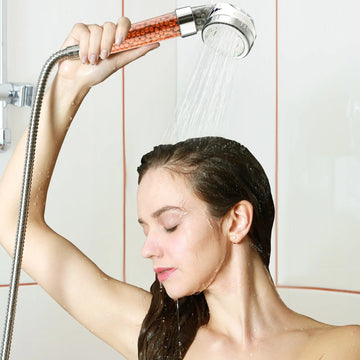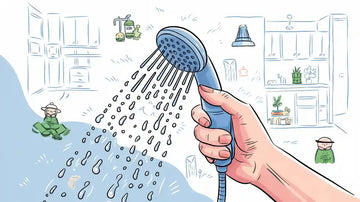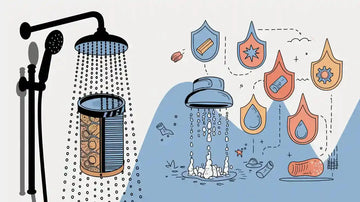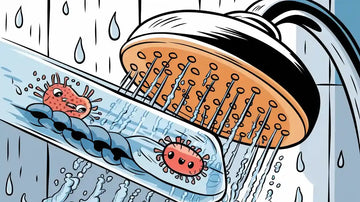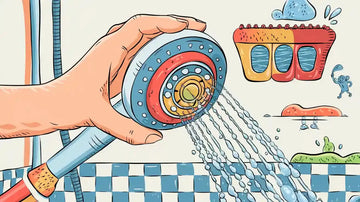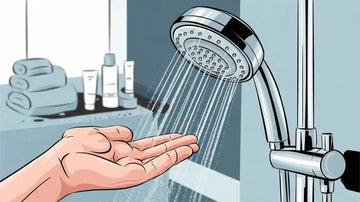Do most people wonder how much water goes down the drain in a shower? Water saving shower heads help with more than just using less water. These devices use smart designs to control how much water comes out. They often lower water use to about 1.75 gallons each minute. This is much less than many regular shower heads. Studies show they help families save thousands of gallons every year. You do not have to give up comfort in your shower. Many people say new designs still give good pressure. This makes every shower both useful and fun.
Key Takeaways
Water saving shower heads use up to 40% less water. They do not make showers less comfortable or weak. Smart designs like aerators and flow restrictors help a lot. They keep water flow steady and strong. This works even if your water pressure is low. Using these shower heads lowers water and energy bills. Families can save over $65 each year on average. These shower heads also help the environment. They cut down on water waste and lower carbon emissions. Most water saving shower heads are easy to put in and take care of. This makes it simple to start saving at home.
Water Saving Shower Heads Technology
Core Technologies
Water saving shower heads use smart ideas to help save water. They still let you have a nice shower. Many have aerators, flow restrictors, pressure chambers, and special nozzles. Aerators mix air with water. This makes the spray feel strong and full. Flow restrictors stop too much water from coming out. Pressure chambers keep the water flow steady. This works even if your house water pressure changes. Nozzle design is important too. Some shower heads use small holes or shapes to spread water evenly.
Moen uses self-pressurizing technology to make the spray stronger. This does not use more water. Their eco-performance shower heads follow strict water-saving rules. Technical papers show these features save water and energy. High Sierra Showerheads lower flow from 2.5 GPM to 1.5 GPM. This can save about 600 gallons of water each month for two people. The EPA WaterSense program sets rules for good shower heads. These rules limit flow to 2.0 GPM and check spray force and coverage. WaterSense shower heads must pass tests to prove they save water and still work well.
Lab tests show low flow faucets and shower heads with aerators and restrictors can cut water and energy use by 20%. This helps families save money and protect the environment. The IoT Smart Shower System project found that water saving shower heads can save about 3,000 gallons of hot water and $100 in bills each year for every shower head. These savings come from using less water and energy.
Tip: When you shop for a new shower head, look for the WaterSense label. This label means the shower head saves water and works well.
Water Flow Science
Water saving shower heads use science to control water flow. They do this without making showers less comfortable. Aerators use the Venturi effect to mix air into the water. This makes a misty spray that feels strong but uses less water. Laminar-flow shower heads work in a different way. They send out single streams of water. This helps keep the water temperature steady and saves more energy.
Modern low-flow shower heads are tested at high pressure, like 80 psi. This makes sure they still give a strong spray. Pressure-compensating valves and flow restrictors keep water flow steady. This works even if the water pressure in your house changes. Studies show these devices can cut water use by up to 33%. They also save energy by using less hot water. Families with efficient shower heads can save about 7,800 gallons of water each year. They can also use about 370 kWh less energy.
Evidence Aspect |
Scientific Finding or Data |
|---|---|
Flow Restrictors Effect |
Reduce showerhead flow by about 33%, cutting water use |
Water Flow Rates |
Modern heads use 1.5 to 2.0 GPM vs. older 5 GPM heads |
Water Savings |
Families can save approximately 7,800 gallons per year |
Energy Savings |
Reduced hot water use saves around 370 kWh annually for a family |
Pressure Maintenance |
Pressure-compensating valves and flow restrictors keep steady pressure |
Low-flow aerators and low flow faucets also help save water in the bathroom. They use the same science to control water flow and work better. Lab and field tests show these devices work well. They help people save water, energy, and money. You do not have to give up a good shower to save.
Conservation and Energy Savings
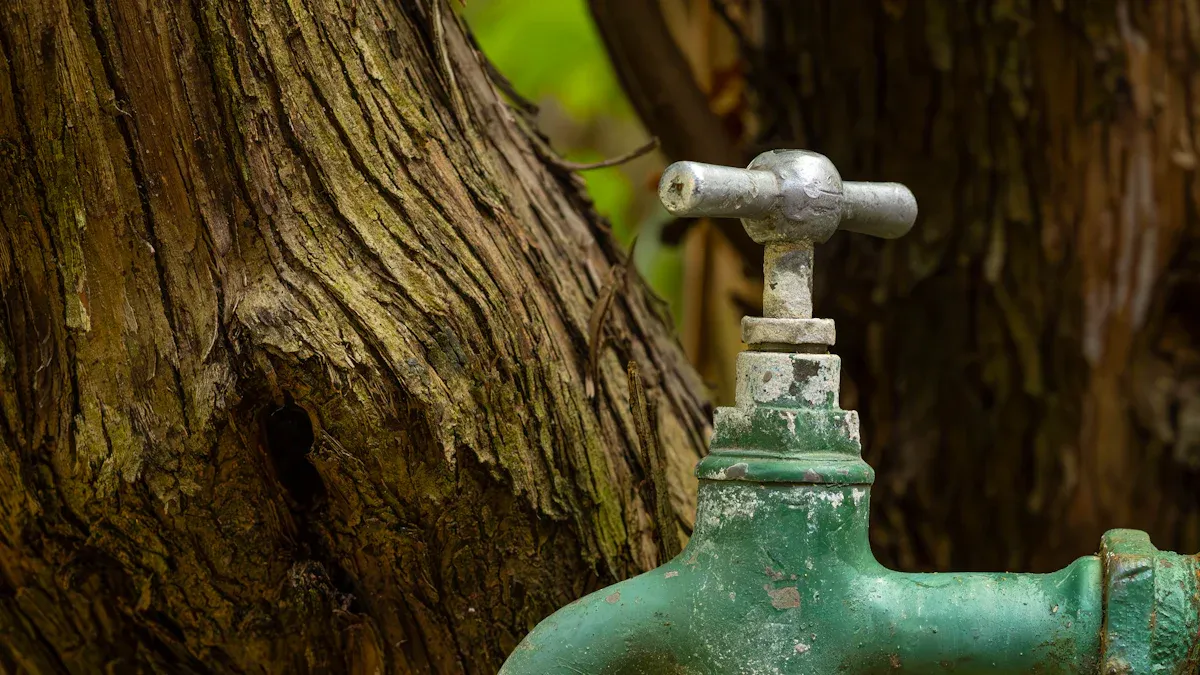
Efficient Shower Heads and Hot Water Use
Efficient shower heads help families use less hot water. Most shower water is heated. Using less water means using less energy too. Old shower heads use 5 to 15 liters each minute. Newer ones, like EcoSmart, use about 8 liters per minute. EcoSmart+ models use 6 liters or even less. This helps families save up to 40% or 60% of their water.
Metric |
Value/Description |
|---|---|
Typical water flow (non-efficient shower heads) |
5 to 15 liters per minute |
Water flow with EcoSmart |
Approximately 8 liters per minute |
Water flow with EcoSmart+ |
Approximately 6 liters per minute or less |
Water savings with EcoSmart |
Up to 40% less water usage compared to non-efficient shower heads |
Water savings with EcoSmart+ |
Up to 60% less water usage |
Annual cost savings (2 people, gas heating) |
Up to 439 euros per year in water and energy costs |
Water saved annually |
Up to 42,705 liters, enough to preserve two buildings' water supply for a year |
Additional technologies |
WaterFlowControl (adjustable volume), SafetyStop (temperature limit), EcoStop (reduces flow to 10 l/min or 6 l/min with EcoStop+) |
These numbers show efficient shower heads save a lot of water. They also use less energy to heat water. Most people do not notice a difference in comfort. But they see lower water and energy use right away.
Lower Utility Bills
Using less hot water means families pay less for utilities. Efficient shower heads lower the amount of water to heat. This cuts water and energy bills. Studies say WaterSense shower heads can save 2,700 gallons each year. This saves money on water, wastewater, and energy bills.
Utility Type |
Annual Savings per Household |
|---|---|
Water Bill |
$16 |
Wastewater Bill |
$19 |
Energy Bill (heating water) |
$30 |
These savings add up over time. A family can save over $65 each year by switching. This easy change helps reduce waste at home.
Note: Saving water and energy does more than save money. It also protects resources for the future.
Environmental Impact
Efficient shower heads help the environment too. Heating water uses a lot of energy at home. It can be 17% to 32% of all home energy use. Using less hot water lowers your carbon footprint. This helps fight climate change.
Heat pump water heaters are much more efficient than old ones. They can save as much energy as six solar panels make in a year.
Switching to a heat pump water heater can cut over 2,000 pounds of CO2 each year.
Over its life, this saves about 12 tons of CO2. That is like planting 17 trees and letting them grow for 10 years.
Supplying drinking water also uses energy and makes CO2. In some cities, using 10% less water could cut emissions by 65,000 tons each year.
Saving water means less energy is needed for heating and supply. This lowers greenhouse gases and helps conservation.
Choosing efficient shower heads is an easy way to help. Families save energy and support the environment. These steps make a real difference for the planet and for the future.
Shower Heads and User Experience
Comfort and Pressure
Modern shower heads care about comfort and saving water. Some people think less water means weak showers. New designs fix this worry. Engineers use special nozzles and pressure chambers. These keep the spray strong. Aerators mix air with water. This makes the spray feel soft and full on your skin. Laminar-flow models send out steady streams. This helps keep the water temperature even. Many people say they cannot tell the difference from regular showers. Hotels and fancy homes pick these shower heads for a spa-like feel. These features help everyone relax in the shower without wasting water.
Smart Features
Smart shower head technology brings new choices to bathrooms. Many models have digital controls for temperature and spray. Users can set their favorite shower style with a button or app. Some systems let each family member save their own settings. Safety features like anti-scald protect from sudden hot water. Automatic shut-off saves water if you forget to turn it off. Self-cleaning nozzles stop mineral buildup. This helps the shower head last longer. LED lights powered by water flow add fun and help you see better. These smart features make showers safer, more comfy, and more efficient.
Tip: Smart shower head systems work well in homes and hotels. They are strong and easy to take care of, even with lots of use.
Real-World Feedback
People who use smart shower heads often give good reviews. Many like changing their shower experience. Some say the water pressure feels just right, even with less water. Families like saving money and still having nice showers. Homeowners who switch to smart shower heads see less cleaning and fewer repairs. In hotels, guests enjoy the luxury feel and new features. Market research shows more people want these products. Consumers want showers that save water, look cool, and have new technology. Comfort, smart features, and savings make these shower heads popular.
Myths About Water Saving Shower Heads
Comfort Concerns
Some people think efficient shower heads are not comfortable. This idea started because old low-flow models felt weak. New designs use better technology to keep the spray strong. Aerating models mix air with water for a full, misty spray. Laminar-flow types send out steady streams. These keep the temperature and pressure even. Flow restrictors control water but keep pressure high. Some shower heads let you change the settings. Most users do not notice less comfort, according to surveys. Only a few people say they enjoy showers less.
Tip: Pick models with adjustable spray patterns for comfort and efficiency.
Common Myths and Facts:
Low-flow shower heads do not always have weak pressure. Modern designs keep pressure high even with less water.
Not every eco-label means you will save water. The WaterSense label shows the shower head works well.
Very low flow rates can make showers less comfy, but most efficient models balance savings and comfort.
Installation and Maintenance
Some people worry that new shower heads are hard to install or care for. Most people can put one in without special tools or skills. You just take off the old head and clean the pipe. Put plumber’s tape on the threads to stop leaks. Screw on the new head by hand. To clean, soak the head in vinegar to remove minerals. Scrub it gently and rinse it off. Check for leaks or cracks often to keep it working well.
Test your water pressure to pick the right shower head.
Take off the old head and clean the pipe.
Use plumber’s tape to help stop leaks.
Screw on the new head by hand.
Clean and check the shower head often.
A local athletic facility saved thousands of gallons each year. They did this by using efficient shower heads and keeping them clean. This proves that good care saves water.
Suitability for Homes
Modern efficient shower heads work in many homes. Test your water pressure to find the best model. Some heads boost low pressure. Others let you change the spray pattern. Most high-efficiency models use 2.0 gallons per minute or less. The WaterSense label means the shower head meets strict rules. Many designs help stop mineral buildup, so they are easy to clean.
Feature |
Benefit |
|---|---|
Adjustable spray |
Each user can pick what feels best |
WaterSense label |
Shows the shower head saves water |
Durable materials |
Lasts a long time in any home |
Advanced models can cut water use by up to half. They also have spray options like rainfall or massage. These features make them good for many homes and different needs.
Water saving shower heads help families use less water and energy. They also help save money at home. New designs use smart technology to keep showers nice and strong. These shower heads can cut water use by up to 40%. They also help lower energy bills and support the environment. Most people say they do not lose comfort or pressure. Anyone can help by switching to a water saving shower head. You can start by checking the flow rate on your shower head at home.
FAQ
How much water can a family save with a water saving shower head?
A family can save up to 7,800 gallons of water each year by switching to a water saving shower head. This helps lower both water and energy bills.
Do water saving shower heads work with low water pressure?
Most modern water saving shower heads use special designs to keep the spray strong, even with low water pressure. Pressure-compensating valves help maintain a steady flow.
Are water saving shower heads hard to install?
Most people can install a water saving shower head in less than 10 minutes. The process usually requires only basic tools, such as a wrench and plumber’s tape.
Will a water saving shower head affect shower comfort?
Many users report no loss of comfort. Aerators and special nozzles help create a full, strong spray. Some models offer adjustable settings for different preferences.
